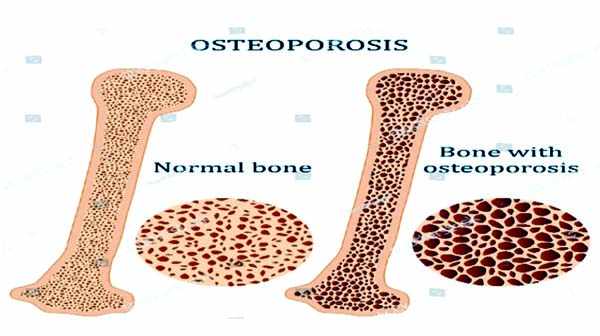
Md. Naim Hossain :
Osteoporosis is a skeletal disorder in which the density and quality of bones are reduced, leading to weakness of the skeleton and increased risk of fracture, particularly of the spine, wrist and hip. This disease often occurs silently without symptom and the first symptom is a fracture, which is an important cause of mortality and morbidity. Several risk factors are associated with osteoporosis, some are modifiable and some are non-modifiable. Non modifiable risk factors include female sex, old age, small thin built, Caucasian/Asian origin, and family history of osteoporosis. Important modifiable factors are calcium and vitamin D deficiency, sedentary lifestyle, smoking, excessive alcohol intake, and caffeine intake.
In the United States, more than 53 million people either already have osteoporosis or are at high risk due to low bone mass. Statistically fracture occurs in everyone in three women and one in five men over the age of 50 years due to osteoporosis. According to International Osteoporosis Foundation about 30-50% female and 15-30% male are at risk of osteoporotic fracture during their life time.
World Osteoporosis day(WOD) takes place every year on October 20, launching a year-long campaign dedicated to raise global awareness of the prevention, diagnosis and treatment of osteoporosis and metabolic bone disease which is organized by the International Osteoporosis Foundation(IOF) year.
Medical conditions like Chronic kidney disease and liver disease, hypogonadism (inability to produce enough testosterone), thyrotoxicosis(excessive thyroid hormone), malabsorption syndrome(disorder in which the small intestine cannot absorb enough of certain nutrients and fluids), anorexia nervosa(eating disorder characterized by low weight), Cushing syndrome(excessive production of adrenocorticotropic hormone), taking corticosteroid medications (prednisone, methylprednisolone) every day for more than 3 months, or taking some anti-seizure drugs, hyperparathyroidism, and inflammatory conditions like rheumatoid arthritis, have a greater than average risk of developing osteoporosis.
Men as well as women are affected by osteoporosis, a disease that can be prevented and treated. For women, bone loss is fastest in the first few years after menopause, and it continues into the postmenopausal years. Osteoporosis – which mainly affects women but may also affect men – will develop when bone loss occurs too quickly or when bone formation occurs too slowly. Osteoporosis is more likely to develop if you did not reach optimal peak bone mass during your bone-building years.
The diagnosis of osteoporosis can be made using conventional radiography and by measuring the bone mineral density (BMD). The most popular method of measuring BMD is dual-energy X-ray absorptiometry.
The risk factors for osteoporosis are well recognized. The most important risk factors for osteoporosis are advanced age and female sex; estrogen deficiency following menopause or surgical removal of the ovaries is correlated with a rapid reduction in bone mineral density, while in men, a decrease in testosterone levels has a comparable effect. Vitamin D deficiency, tobacco smoking, malnutrition, underweight/inactive, soft drinks, excess consumption of alcohol etc. is potentially modifiable risk factors. Certain medications have been associated with an increase in osteoporosis risk.
5 Ways to Keep Bones Healthy
1. Eat a well-balanced diet with plenty of dairy, fish, fruits, and vegetables.
2. Exercise regularly to reduce the rate of bone loss and retain calcium in the bones.
3. Avoid smoking and limit alcohol.
4. Get vitamin D from early morning sunlight.
5. Reduce stress which is crucial to bone health
Osteoporosis should be treated not only by drugs but also with advice on lifestyle, nutrition, exercise and measures to reduce fall. Ensuring adequate calcium and vitamin D status, with supplements that should be given if required, may help to reduce the risk of osteoporosis.
Bisphosphonates are useful in decreasing the risk of future fractures in those who have already sustained a fracture due to osteoporosis.
( Md. Naim Hossain is a student at
Department of Pharmacy, Bangabandhu Sheikh Mujibur Rahman Science and Technology University).

